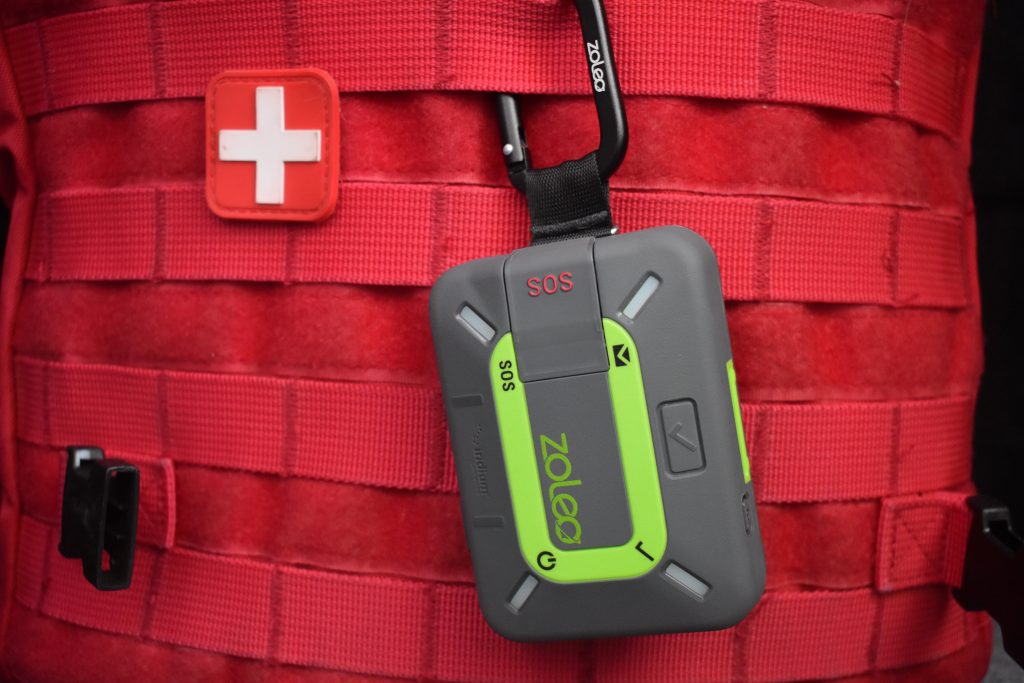
Since the debut of Garmin’s InReach, satellite communicators have gained massive traction in the outdoor market. The ability to contact emergency services regardless of cellular connection removed one of the greatest barriers for people to go off the beaten path, allowing adventures to reach more remote locations with greater confidence. Today, many companies have incorporated additional features such as weather reports, messaging, and location tracking, which have furthered the satellite communicator’s popularity.
Here’s the catch– Garmin’s entry-level satellite communicator, the InReach Mini, starts around $350 (at the time of this article’s publication). On one hand, it’s easy to justify spending several hundred dollars on a potentially life-saving device. However, that’s a lot of money to spend on something you will likely never use, especially when you account for the monthly fees to activate the device.
An emerging company called ZOLEO is helping to offset this issue with their option, which comes in at nearly half the price of an InReach Mini. In this article, we’ll break down the features of this device, set it up, and evaluate why it might be tailored to your overland needs.
- We have a free activation code to save money ($20)! Use TRAILCO.
- Device currently on sale for only $149!
Table Of Contents
The Basics
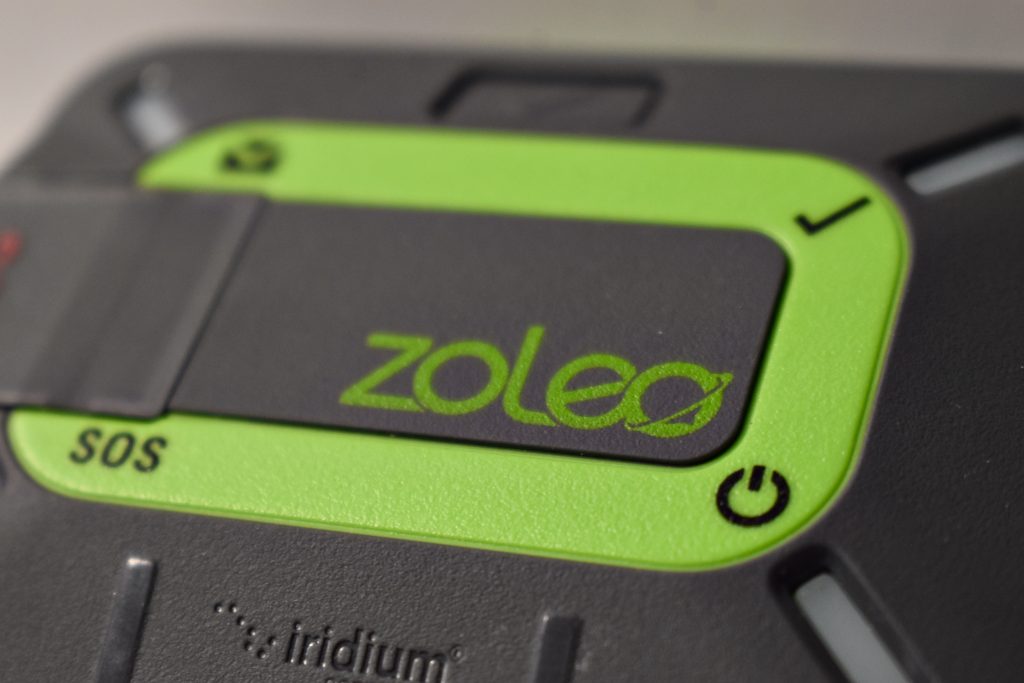
Let’s start with the basics. The ZOLEO unit interfaces with the Iridium Satellite Network, allowing you to interact with its features from anywhere in the world. Simply place your unit face-up with an unobstructed line-of-sight with the sky, and you’ll have access to the following features:
- Satellite SOS alerts that communicate directly with a 24/7 SOS monitoring service
- Messaging with a medical assistant for non-emergent medical questions
- Two-way satellite messaging with any email or phone number
- Unlimited check-in messages to keep loved ones updated
- Automatic location sharing, so friends and family can follow your expedition in real time
- Instant weather reports for your location
- Your own personal ZOLEO SMS number and email address
These features are unlocked through their app, which can be downloaded for free on iOS and Android. SOS alerts can be sent without connection to a phone, allowing for rapid activation in a true emergency. The remaining features require a Bluetooth connection using the app, which holds a connection for over 150 feet. Here are some additional tech specs:
- Weight: 5.3 oz
- Battery life: 200+ hours
- Dust-, shock- and water-resistant (to 5 ft of submersion for 30 minutes)
- Internal GPS accurate to 8.2 ft
- Covered SOS button to prevent false activation
- Carabiner included for versatile mounting
Unboxing & Setup
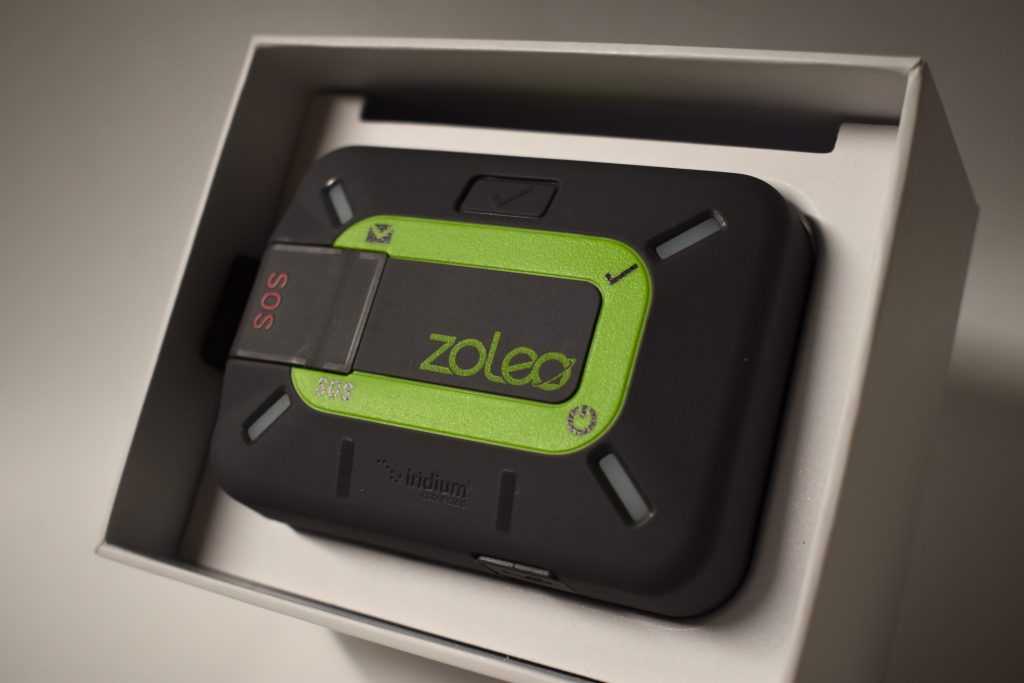
Setup for the ZOLEO is extremely straightforward and will take only a few minutes. First, you’ll need to charge it. While it’s charging, download the app, navigate to their site activation page, and input your unit’s unique serial number to activate the device. Once you have selected a plan and created your account, you’ll be able to connect your device to your phone via Bluetooth. It’s as simple as that! You are now free to use all of the features included with your plan.
Author’s note: I recommend sending a test message to become familiar with everything. It’s worth noting that the message will not be sent from your typical email or SMS number, so the recipient may not realize it’s from someone they know unless you include a brief explanation (or at the very least, your name) in the message.
Choosing A Plan
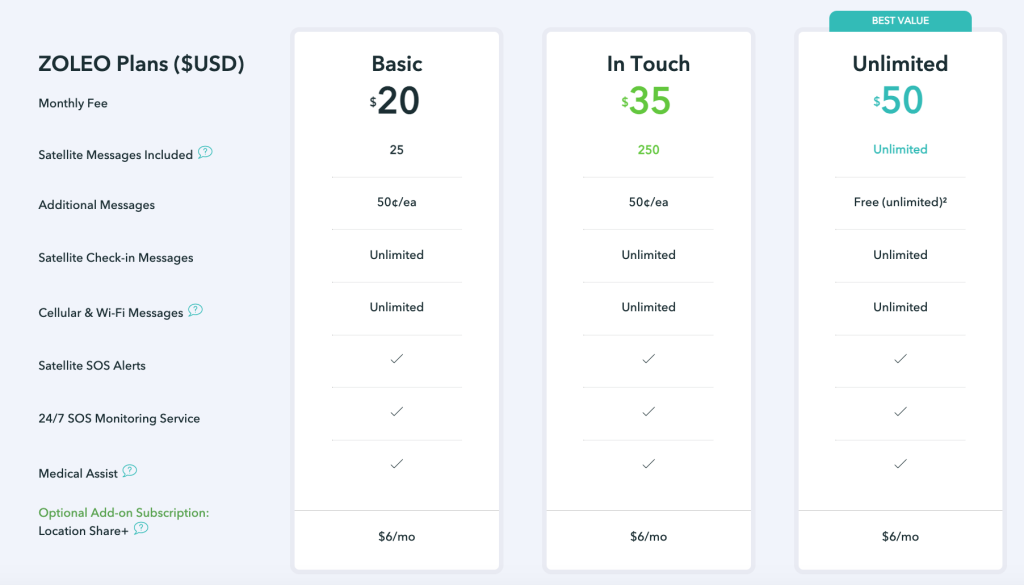
At the time publication, they offer three plans: basic, in touch, and unlimited.
The primary difference between plans is the number of messages you can send each month, ranging from 25, 250, to unlimited, respectively. Do keep in mind that weather reports and messages with the medical assistant do count toward your monthly total while SOS alerts and check-in messages do not. You can also add on a Location Share+ subscription, which allows you to send unlimited location share messages to any contact at a pre-set interval. This is a great option for that spouse or parent who will sleep easier when they can follow your adventures from home and know you’re safe.
The plan you choose will depend largely on your mission. For the majority of us who are primarily just looking for the confidence of having an SOS button and might send a few messages here and there, the basic plan is more than sufficient. However, for those who venture further off the grid, especially for longer expeditions, the higher plans are the ideal choice. The unlimited plan is also great for families or large groups who all want to send messages through a single device.
What Happens When You Press SOS?
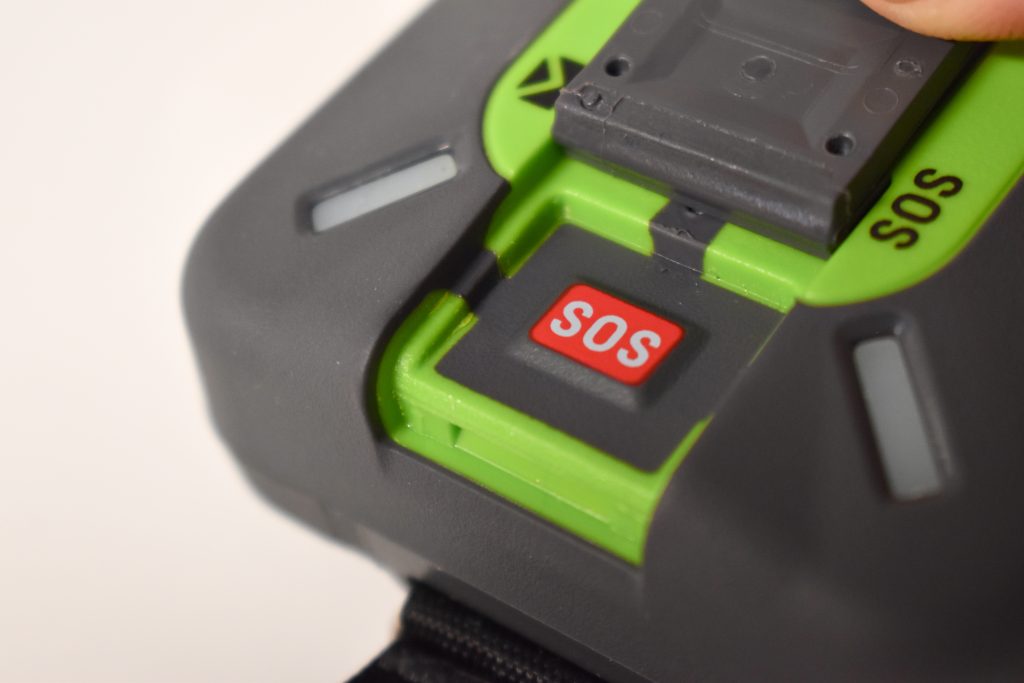
This is the exact reason why most people choose to purchase a satellite communicator: something goes wrong in the wild and you press the dreaded red button to activate emergency services, but what actually happens? How do I know I’ll be safe if I activate SOS in an emergency?
When you press the SOS button, the ZOLEO will automatically send a satellite alert to their 24/7 SOS Monitoring Service. This alert will include the device’s current location and your account information. The emergency contacts you selected when you activated your device will be notified and as much information as possible will be gathered from your contacts, account, and direct two-way messaging.
From there, ZOLEO’s SOS monitoring service will pass the information along to the appropriate local agency. Depending on your location, this may include a fire rescue team, law enforcement, or most likely, search and rescue. After pressing the SOS button, it’s crucial to not move locations if at all possible. Rescue teams will be dispatched to the location attached to the SOS alert, so it’s best to stay put for the fastest extraction.
The vast majority of rescues take place on foot, so it may be several hours before help arrives. As with any emergency, it’s crucial to stay calm and think clearly. If possible, use your unit to relay as much information as possible, including the nature of the emergency, a description of the terrain around you, and any unique needs that might complicate the rescue. If weather conditions permit and it is deemed necessary, technologies such as ATVs, drones, or helicopters may be used to speed up the search. Finding a nearby clearing, wearing bright clothing, waving your hands, or starting a signal fire may help rescue teams find you.
Communication For Off-Roaders & Overlanders
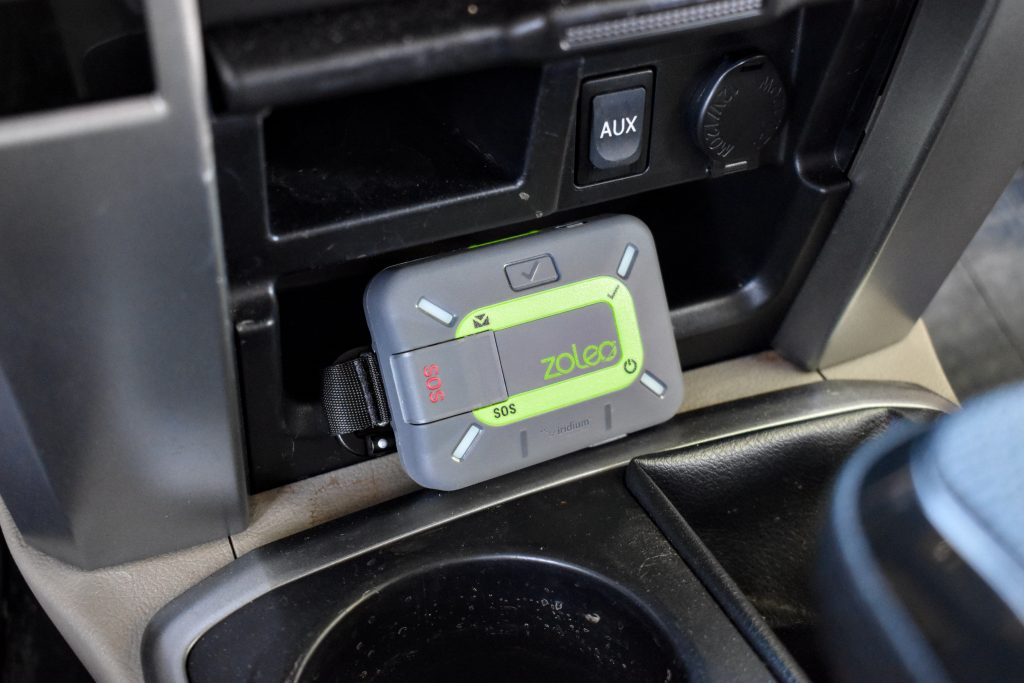
Is it worth purchasing a satellite communicator for my overland rig? I’d argue, yes.
For a fraction of the price of mods many of us put on our rigs to simply improve their aesthetic or comfort, you can massively boost your safety on the trail and get further off the grid with greater confidence. Even if you never end up pressing SOS once, the luxury of being able to message your loved ones from the middle of a remote forest, the relief your spouse or parent will have from knowing you’re safe each night, and the added confidence you’ll be able to wheel with will all make it well worth the cost. And, in the event that you do encounter an emergency that requires search and rescue, it may just be the best $150 you ever spent.
Final Thoughts
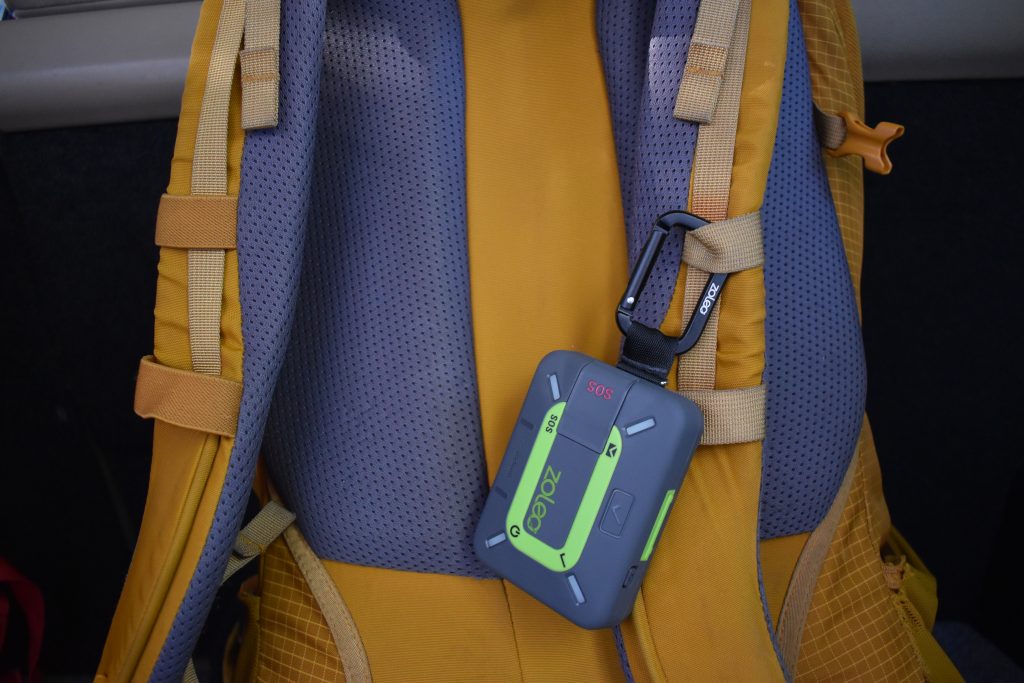
As a field-active member of my local search and rescue team, I can testify that satellite communicators like this one can save lives. In an emergency, every hour someone spends in the field without care dramatically decreases the likelihood of survival. Using a communicator to activate emergency services eliminates the several hours or even days it takes for a family member to notice that someone is overdue or missing. Additionally, knowing the victim’s exact location allows rescue teams to respond directly to the scene, which eliminates additional hours or days without care.
Whether you’re a full-time overlander who spends weeks at a time out off cellular connection or a weekend warrior who wants something to carry in your pack in case of an emergency during a side excursion, the ZOLEO Satellite Communicator is a worthy addition to your gear arsenal and belongs at the top of your wish list.

I’ve had mine for a couple years now, and it has turned out to be very useful. Regular “I’m fine and this is my location” notifications to family while out on a long solo trip helps a lot. I’ve used it in Africa to let family members of the whole team know we were safe, and the breadcrumb option is great to allow people to follow along with your route. I’ve used it offshore for health and safety check ins as well. I used to just activate it for trips, but now I leave it on for hurricane season incase we lose power, cell service or have to evacuate, I’ll still have at least text options for communication with the outside world.
Thx for your review and recommendation. I second your recommendation that EVERYONE should enter the wilderness with a satellite emergency SOS contact device. I carry Garmin’s Messenger myself, but the Zoleo is a excellent device for the same purpose. Noone should go into the woods with only a cellphone.
100%. For as much as we invest in preparing our vehicles for the unexpected (Maxtrax, winches, recovery ropes, etc.), satellite communicators have the potential to be equally, if not more lifesaving.
For those not needing quite as many features, Iphone 14 and newer currently has satellite “sos” (Globalstar sats), and will have messaging and GPS pin dropping shortly when IOS 18 is released- free at least until late 2025 and available in all US and 17 countries. Google pixel has similar functionality.
I just had the chance to test out this new function. It works great, and it’s nice to only have to worry about keeping one device charged. I’m curious to see how companies like Zoleo and Garmin respond to this.
I enjoy the Zoleo for communication back home when we are out of cell range. I am getting the hang of the user interface which is not very intuitive. It is worth emphasizing that if you want to send messages with it you better make sure your phone is charged though you don’t need a phone to send an SOS. Also, the company says that messages will arrive quicker if both parties have the app (only one needs to be a subscriber, but if one side isn’t, they must be able to send/receive text messages via cell or wifi). But it works very well, and for checking in on a sick family member or coordinating meeting locations it has been very useful.
Great information dude. I have one of these and I’ll be testing it out shortly! Seems to be a nice alternative to Garmin…
Dude, this thing has been awesome. I used it yesterday on a Search and Rescue call to check in with the family while out of service. Was also able to pull the weather reports for rain that afternoon.